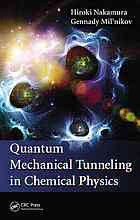Table Of ContentQuantum
Mechanical Tunneling
in Chemical Physics
Quantum
Mechanical Tunneling
in Chemical Physics
Hiroki Nakamura
Gennady Mil’nikov
Boca Raton London New York
CRC Press is an imprint of the
Taylor & Francis Group, an informa business
CRC Press
Taylor & Francis Group
6000 Broken Sound Parkway NW, Suite 300
Boca Raton, FL 33487-2742
© 2013 by Taylor & Francis Group, LLC
CRC Press is an imprint of Taylor & Francis Group, an Informa business
No claim to original U.S. Government works
Version Date: 20121218
International Standard Book Number-13: 978-1-4665-0732-6 (eBook - PDF)
This book contains information obtained from authentic and highly regarded sources. Reasonable efforts
have been made to publish reliable data and information, but the author and publisher cannot assume
responsibility for the validity of all materials or the consequences of their use. The authors and publishers
have attempted to trace the copyright holders of all material reproduced in this publication and apologize to
copyright holders if permission to publish in this form has not been obtained. If any copyright material has
not been acknowledged please write and let us know so we may rectify in any future reprint.
Except as permitted under U.S. Copyright Law, no part of this book may be reprinted, reproduced, transmit-
ted, or utilized in any form by any electronic, mechanical, or other means, now known or hereafter invented,
including photocopying, microfilming, and recording, or in any information storage or retrieval system,
without written permission from the publishers.
For permission to photocopy or use material electronically from this work, please access www.copyright.
com (http://www.copyright.com/) or contact the Copyright Clearance Center, Inc. (CCC), 222 Rosewood
Drive, Danvers, MA 01923, 978-750-8400. CCC is a not-for-profit organization that provides licenses and
registration for a variety of users. For organizations that have been granted a photocopy license by the CCC,
a separate system of payment has been arranged.
Trademark Notice: Product or corporate names may be trademarks or registered trademarks, and are used
only for identification and explanation without intent to infringe.
Visit the Taylor & Francis Web site at
http://www.taylorandfrancis.com
and the CRC Press Web site at
http://www.crcpress.com
Contents
Preface...................................................................ix
Chapter1 Introduction...................................................1
Chapter2 One-DimensionalTheory.......................................5
2.1 ExactlySolvableCases....................................5
2.1.1 CaseofDelta-FunctionBarrier.....................5
2.1.2 CaseofParabolicPotentialBarrier..................6
2.1.3 CaseofEckartPotentialBarrier....................8
2.2 WKBApproximationandConnectionFormula.............10
2.3 ComparisonEquationMethod.............................11
2.4 DiagrammaticTechnique.................................13
2.5 InstantonTheoryandModifiedWKBMethod..............16
2.5.1 InstantonTheory................................16
2.5.2 ModifiedWKBMethod..........................24
2.6 EnergyLevelsinaDoubleWellPotential..................26
2.6.1 AsymmetricDoubleWellPotential................26
2.6.2 SymmetricDoubleWellPotential.................28
2.7 DecayofMetastableState................................29
Chapter3 Two-DimensionalTheory......................................33
3.1 WKBTheory............................................33
3.2 InstantonTheory........................................40
Chapter4 MultidimensionalEffects:PeculiarPhenomena...................43
4.1 EffectsofVibrationalExcitationonTunnelingSplitting......43
4.1.1 AdiabaticandSuddenApproximations.............43
4.1.2 CaseofSymmetricModeCouplingPotential.......44
4.1.3 CaseofAntisymmetricModeCouplingPotential...49
4.1.4 CaseofSqueezed(Sqz)DoubleWellPotential......50
4.2 InsufficiencyofTwo-DimensionalModel..................54
4.3 ProtonTunnelinginTropolone............................54
4.3.1 AvailableExperimentalData......................54
4.3.2 TunnelingDynamicsintheGround X˜ State........56
4.3.3 AnalysisofTunnelingDynamicsofthe
Excited A˜ State. ................................. 59
Chapter5 NonadiabaticTunneling.......................................61
5.1 DefinitionandQualitativeExplanation.....................61
5.2 One-DimensionalTheory.................................64
5.2.1 Caseof E ≤ E .................................67
t
5.2.2 Caseof E ≤ E ≤ E ............................68
t b
5.2.3 Caseof E ≤ E .................................68
b
v
vi Contents
Chapter6 MultidimensionalTheoryofTunnelingSplitting..................75
6.1 GeneralFormulation.....................................75
6.1.1 MultidimensionalExtensionofthe
InstantonTheory ................................75
6.1.2 WKBApproachinCartesianCoordinates..........82
6.1.3 WKBApproachintheCaseofGeneral
HamiltonianinCurvedSpace.....................85
6.2 HowtoFindInstantonTrajectory..........................89
6.3 HowtoUsetheTheory...................................92
6.3.1 EvaluationofthePre-ExponentialFactor...........92
6.3.2 IncorporationofHighLevelofabinitio
QuantumChemicalCalculations...................95
6.4 CaseofLowVibrationallyExcitedStates...................96
6.4.1 One-andTwo-DimensionalCases.................96
6.4.2 MultidimensionalCaseinTermsof
CartesianCoordinates............................99
6.4.3 CaseofGeneralMultidimensional
CurvedSpace..................................103
Chapter7 NumericalApplicationstoPolyatomicMolecules...............109
7.1 N-DimensionalSeparablePotentialModel................109
7.2 HydroperoxyRadicalHO ..............................111
2
7.3 VinylRadicalC H .....................................120
2 3
7.4 MalonaldehydeC O H .................................128
3 2 4
7.5 FormicAcidDimer(DCOOH) ..........................139
2
Chapter8 DecayofMetastableStates...................................149
8.1 GeneralFormulation....................................149
8.1.1 DeterminationofInstantonTrajectory............149
8.1.2 FormulationinTermsofCartesianCoordinates....151
8.1.3 GeneralCanonicallyInvariantFormulation........154
8.2 NumericalApplication..................................158
Chapter9 TunnelinginChemicalReactions..............................163
9.1 DeterminationofCausticsandPropagationin
TunnelingRegion ......................................163
9.1.1 CausticsinChaoticHenon-HeilesSystem.........166
9.1.2 CausticsinChemicalReactionDynamics.........167
9.2 DirectEvaluationofReactionRateConstant..............174
9.2.1 AdiabaticChemicalReaction....................174
9.2.2 NonadiabaticChemicalReaction.................178
Chapter10 ConcludingRemarksandFuturePerspectives..................183
Contents vii
AppendixA ProofsofEquation(2.95)andEquation(2.110)...............185
AppendixB DerivationofEquation(6.80)...............................187
AppendixC HerringFormulainCurvedSpace...........................189
AppendixD DerivationofEquation(6.97)...............................191
AppendixE ComputerCodetoCalculateInstantonTrajectory..............193
AppendixF DerivationofSomeEquationsinSection6.4.2................201
Bibliography............................................................205
Index...................................................................213
Preface
In this book we mainly discuss the following three tunneling phenomena based on
our recent theoretical developments: (1) energy splitting, or tunneling splitting, in
symmetricdoublewellpotential,(2)decayofmetastablestatethroughtunneling,and
(3)tunnelingeffectsinchemicalreactions.Thecorrespondingphysicalprocessescan
benaivelyunderstoodintermsofareactionpathinwhich(1)twoendpointsarefixed,
(2) one endpoint is fixed and one is free, and (3) both ends are free. Quantum me-
chanicaltunnelingmanifestsitselfinaverywiderangeofnaturalphenomenaandthe
subjectswedealwithhereconstituteonlyasmallportionofthewholearea.Inspite
ofthelonghistoryofstudiesofquantummechanicaltunnelingphenomena,however,
thetheoryofmultidimensionaltunnelinghasnotyetbeensatisfactorilydeveloped.
Recently, we have successfully developed practical and useful methods applicable
torealmultidimensionalsystemsfortheabove-mentionedproblems.Basictheories,
practicalmethodologies,andactualnumericalapplicationstorealmolecularsystems
are presented so that the reader can hopefully comprehend the basic concepts and
dynamics of multidimensional tunneling phenomena and use the methods directly
in various problems of molecular spectroscopy and chemical dynamics, if neces-
sary. Insufficiency of the low-dimensional treatments that are often employed for
practical problems and intriguing effects of multidimensionality are demonstrated
and clarified conceptually as well as numerically. Furthermore, attention is called
to the nonadiabatic tunneling phenomenon, which is quite ubiquitous in molecular
systemsandyetmanifestsuniqueandintriguingphenomenonincomparisonwithor-
dinarytunneling.Inthisbook,quiteabitofmathematicsisusedforthedevelopment
and explanation of basic theories; thus a background knowledge of mathematics
is required at the level of graduate students. This book is intended as a standard
reference for comprehending the phenomena and solving practical problems in the
fields of chemical physics. H. N. mainly wrote the whole contents and thus is re-
sponsibleforallchapters.G.M.sharesresponsibilityforChapters6,7,and8and
Section9.1.
We would like to thank all the collaborators for their contributions in the de-
velopment of the methods and various applications to real molecular systems that
clearly demonstrate the usefulness of our methods. H. N. would like to express his
sincere thanks to National Chiao Tung University in Hsinchu, Taiwan, and people
attheInstituteofMolecularScience,DepartmentofAppliedChemistry,Facultyof
Science of the university for providing this nice opportunity to work on this book.
Especially,heisdeeplyindebtedtoProfessorsS.H.LinandY.P.Leefortheirhos-
pitality. G. M. thanks his colleagues and friends in Okazaki who have turned this
placeintohissecondhometownafterspendingsevenwonderfulyearsintheInstitute
forMolecularScience,NationalInstitutesofNaturalSciences.Acknowledgmentis
alsoduetothefollowingsocietiesandpublishersforpermissionofreproducingvari-
ouscopyrightmaterials:AmericanInstituteofPhysics,AmericanChemicalSociety,
ElsevierScienceB.V.,andWorldScientificPublishing.
ix

